
by Pam Ranheim | Mar 26, 2021 | cats, dogs, pet care, pet health, Plymouth MA
Having a clean home protects us from harmful bacteria and viruses and creates a healthy and comfortable atmosphere. For homes with pets, cleaning your home in a pet-friendly way is essential. Household cleaners are a common cause of poisoning for cats and dogs, so you must know which cleaning products are safe and pet friendly.
Effects of Toxins
Toxins are bad for our health and are harmful to the planet. Many people think you have to ingest the chemical for it to be dangerous. However, toxins are just as damaging to breathe in as to be around. These toxins pose a threat to us and our pets. The contact made with these chemically cleaned surfaces can negatively affect our pets’ health.
Inhaling or ingesting chemicals can have dangerous effects on our pets, especially with their heightened senses of smell. Being around toxic chemicals can cause dizziness, headaches or nausea. Ingesting poisonous chemicals can have life-threatening effects. If you think your pet has ingested a chemical, take them to the vet right away.
Going Green and Pet-Friendly
There’s no time like the present to change your ways. You can make your natural products at home. These DIY products will be safe for your family, including your pets, and you’ll know everything that’s in them. It’s also quick, easy and cost-effective!
Making homemade pet-friendly cleaning products does save you money in the long run. However, pet-friendly and green products are popular in the market and can be purchased commercially. Make sure you do your research before buying any cleaning product.

Getting Started
Many people don’t want to throw out the commercial products that they have on hand – and rightly so. We recommend starting simple and gradually swapping your commercial cleaners for pet-safe and homemade organic products as you finish those toxic bottles. We promise it’s a lot easier than it seems!
When you’re ready to replace your old chemicals, we recommend you start collecting the following products:
- Spray bottle
- Distilled water or boiled (then cooled) tap water
- Box of baking soda
- Table salt
- Bottle of white distilled vinegar
- Oils (almond, olive, vitamin E, mineral, coconut)
- Castile Soap (bar or liquid form)
- Fresh lemons.
- Washcloths or old rags
- Pure, essential oils (which are great for their antiseptic, antibacterial qualities) smell so good: Rosemary, tea tree, lavender, rosemary, peppermint, and lemongrass are just a few).
A simple search online can result in many free recipes. From carpet cleaning, carpet stains, floor cleaning and eliminating pet odors, there is a recipe for all household cleaners. With these natural ingredients, you can create many organic pet-safe cleaning products for all your household chores.
Helpful Resources
If you prefer to have a personal copy of pet-safe organic cleaning products, we recommend the book “The Organically Clean Home: 150 Organic Cleaning Products” by Becky Rapinchuk. It comes with simple instructions on how you can get started. It also contains many practical hints along the way. This book has received great reviews, and it’s FREE if you subscribe to kindle unlimited!
Here’s a sample of an easy pet-safe recipe from “The Organically Clean Home: 150 Organic Cleaning Products”:
Liquid Dishwasher Detergent
What you need:
1 cup of castile soap
¼ cup distilled water (or tap water that is boiled and cooled)
1 teaspoon of lemon juice
5 drops of essential oil (lemon)
Combine the ingredients, and voila! Use one tablespoon of the mixture per load and run your dishwasher as you normally would. Becky suggests putting distilled white vinegar in your dishwasher’s rinse compartment if you’re worried about hard water spots. This detergent also lasts and has a 3-week shelf life!
Contact Us
We believe that cleaning your home in a pet-friendly way can not only improve your pet’s life but your life as well. These organic mixtures and cleaning remedies will give you one less thing to worry about your pet’s health and safety. If you would like to know about the pet-safe cleaning products we use for pet sitting and disinfecting, please contact us.
Just Around the Corner offers daily Dog Walking , Dog Hiking, and Pet Sitting in Plymouth, MA. To learn more about how Just Around the Corner can help, check out our Services Page. You can also Contact Us for more information. Be sure to Like us on Facebook and Follow us on Instagram!
We’d love to hear what your “go-to” natural cleaning products are? Happy cleaning!
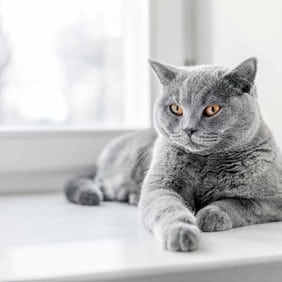
by Pam Ranheim | Feb 18, 2021 | cats, pet care, pet health, pet lovers, pets, Plymouth MA
Whether you have a cat, are about to bring home your first, or are pet sitting a kitty in your home for a short time cat proofing your home is a must. Anytime we prepare to bring cat into our home no matter how long or short their stay, we must first make their environment safe and secure. Not only is this crucial for keeping the cat safe throughout their time in your home but it provides much peace of mind for you too. Let’s break down every room of your house to share the best ways to cat proof your home.
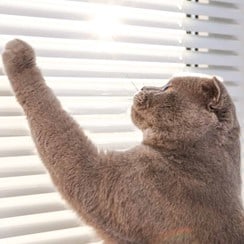
A cat playing with a cord of a set of blinds
Living Room
Tie up blind cords. Oh, the fascination of a long, lanky blind cord! While these common ribbons of material are the best thing since catnip to our kitties, they pose certain dangers that you want to avoid. Playtime with a blind cord can quickly turn into a tangled mess escalating fear and frustration in our kitties. A caught paw could become a broken bone and even, God forbid, a choking hazard almost immediately. Avoid disaster and tie up those intriguing blind cords.
Hide electrical cords. Who doesn’t love a long cord to play with, chew on, and even befriend? Well maybe not you, but your cat sure does. Wherever possible secure all electrical cords either tightly against a wall or hidden in a space your cat cannot reach. Avoiding electrocution is key to being a successful cat parent, hide the electrical cords.
Cover outlets. If you are a cat owner already you know that felines have an innate sense of what they are not supposed to do and go right for it, right? These curious little areas on the wall are no exception. Electrocution aside, their claws can easily get stuck in the tiny holes of an outlet and cause major pain.
Candle with care. Flames are intriguing to our curious kitties. Be sure to always place your candle up high or in an area that your cat cannot or will not get to. Even when a candle is not lit avoid letting the candle become a play toy. Once a cat feels like something is theirs to play with, whether it is lit or not, they will not make a distinction between times they can and cannot play with it. Candle with care my friends.
Check if a plant is poisonous before bringing it into your home. Always, always, always check here to see if a plant is poisonous to your pets before bringing it into your home. There is a surprising amount of quite common plants that are poisonous to our beloved fur babies. Do not assume, always check the poisonous plants to pets list first!
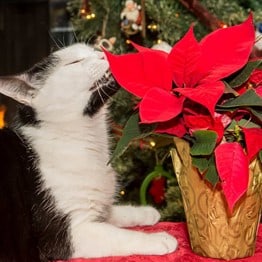
A cat smelling a poisonous poinsettia
Kitchen
Stovetop safety. This is more about a “redirection” routine for when your cat decides to dance on the stove top. Establish a ground rule that being on the stovetop, no matter when, is never allowed to keep your curious felines save. Whether you use a spray bottle or blow a whistle to signal the current action is not acceptable, decide what works for you and choose something your cat can understand.
Keep drawers and cabinets closed. The kitchen houses many potentially dangerous items so it is best to avoid “playtime” all together in this area. In addition, be mindful of closing cabinets and drawers immediately after use. We all know how sly and quick our kitty cats can be and the next thing you know they are playing with the Ninja blade at the back of your corner cabinet! Keep cabinets and drawers closed and keep your kitty safe.
Countertop awareness. Remember that there is a cat constantly roaming around every room of your home looking for interesting things to play with. Do not leave hot pots/pans or other potential dangerous yet intriguing kitchen tools unattended. When not in the kitchen clear your countertops of any knives, blenders, mandolins, etc. Your cat may never show an interest in being on the kitchen counter, but don’t underestimate the power of a bored cat. You can never be 100% sure a cat won’t do something, am I right?
Keep trash securely covered. Keeping the trash covered always is extremely important. After all, what we put into these shiny barrels is TRASH. Whether it’s rotten food, raw chicken packaging, or plastic bottle ties (which we sincerely hope you cut up before placing in your bin) nothing good comes from a cat getting into a trash can. Avoid a choking catastrophe or an emergency vet visit be putting a lid on it.
Bedroom/ Office Space
Keep nightstands and desks clear of potentially dangerous items. We all have our evening routines whether putting on creams, taking nightly meds, or even sewing up a hole in your spouse’s work shirt. Kitty thinks wahoo! It doesn’t get much more intriguing than string with a shiny needle attached or the chattering sound of pills when they bat at the container with their paw. Whatever your routine looks like be sure to have a proper place to securely put those items away when they are not actively being used.
Hide mothballs. Do not leave mothballs out in the open. Always hide them in a drawer or up on a shelf in your closet. Place them anywhere that your cat cannot get to as they are toxic to our precious kitties.
Research your essential oils. Not all essential oils are safe for pets. If you love running your diffuser even just occasionally be sure to research the types of oils you are using first. Click here for a list of oils that are toxic to pets.
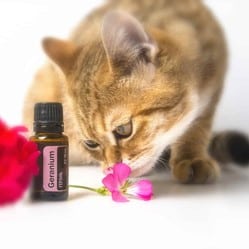
Cat smelling a flower and essential oils
Bathroom
Cover the trash. Just like the kitchen these curious bins that house all the things their humans don’t want/need anymore is just too much not to play with. Dental floss in particular must be avoided as it can easily be ingested and cause major intestinal issues. Keep all trash bins throughout your home covered for optimum pet safety.
Always put the toilet seat lid down. This is particularly important for new kitties. They can easily slip and fall into the toilet bowl when trying to climb the toilet. Avoid disaster by simply keeping the toilet seat cover closed.
Laundry Room
Safety container for detergent. Laundry detergent not only smells wonderful, but it looks exciting too! This is particularly true of those convenient detergent pods that are so popular these days. After all, to a cat those colorful pods are the perfect size for them to play with and who can avoid sinking their teeth into the rubbery, ooey gooey-ness?! Avoid temptation and keep all detergents and fabric softeners in a secured cabinet or container.
Keep washer and dryer doors closed. You have heard the horror stories, don’t let it happen to you! Always close the doors to your washer and dryer to keep your kitty out. If you need to air out the washer be sure to check that your cat is not anywhere in the room before shutting the door to the laundry room itself. Only then should you leave the door to one of these machines open.
Double check before starting a new laundry cycle. Even when we exercise proper precaution and keep the doors to our washer and dryer closed our kitties can act in the blink of an eye. Always doublecheck the drum of your machines for your curious kitty before shutting the door and starting a new wash/dry cycle.
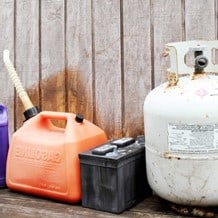
Hazardous household materials
Storage Spaces
Store Chemicals and hazardous materials safely. From car oil to rock salt always keep chemicals and other hazardous materials in proper bins, containers, or out of reach locations. Even if you keep all these items in your garage where your cat “never goes” we all have had those moments with Felix senses a mouse or gets the itch to run out the door into the garage for no apparent reason. It is better to be safe than sorry. Keep hazardous materials safe and secure to avoid disaster.
There you have it! With every room in the house safely secure for your fur baby to live, play, and love as they please you can enjoy peace of mind and harmony. Just remember, never underestimate the power of curiosity in your cat. Have experience cat proofing your home? Share your tips in the comments below!
Just Around the Corner offers daily Dog Walking , Dog Hiking, and Pet Sitting in Plymouth, MA. To learn more about how Just Around the Corner can help, check out our Services Page. You can also Contact Us for more information. Be sure to Like us on Facebook and Follow us on Instagram!

by Pam Ranheim | Jan 20, 2021 | dog hiking, dogs, pet care, pets, Plymouth MA, puppy
Ok, so maybe you have been a dog owner all your life or maybe you are just about to pick up your very first puppy. No matter how much or how little experience you have we could all use some amazing tips in our pet parenting tool belt, right?! If you are looking to lay a positive puppy foundation, build a stronger bond with your dog, and keep your pet happy and healthy year-round, look no further! It’s time to dive into 5 tips that will change your life as a pet parent!
1. First things first: Puppies
Let’s start at the very beginning, shall we? Have you ever had a dog who wouldn’t let you clip their nails or even brush behind their ears? You are not alone; this is far more common than you might think. When you first get a new puppy there are certain things you can introduce to them right off the bat to avoid potential difficulties in the future. As a pup much of their fear, like a baby, has not developed yet. The window of opportunity to familiarize them with things that have the potential to become frightening to them is smaller than you might think. We suggest starting the introduction process as soon as your fur baby arrives and maintaining consistency throughout puppyhood. Below is a list of activities to use as a starting point along with suggested timing. Every household is different so add or take away based on what makes the most sense for you and your new family member.
- Nail clipping: multiple times a week, even if you just pretend it will get them used to the clippers, the sounds, and the feeling of you touching their paws.
- Brushing: daily, use a few different types of brushes on any given week to alter the feel, this will help them to feel more comfortable when they go to the groomer, who uses a different brush than they are “used to”.
- Bathing: weekly, they may not always need it and it may be best not to shampoo every week (to keep their skin from drying out) but it is important that they practice getting in the tub/shower/clam shell and all the actions that go along with getting a bath. This will make you and your groomer’s life much easier in the future.
2. The Great Pumpkin
Pumpkin is a super food for our pups! It is no secret that every dog experiences diarrhea at some point in their lives. If your dog is having tummy trouble and producing soft/runny stool, try giving them a scoop of pumpkin. Pumpkin is rich in fiber which helps to ease digestion, absorbs water, and supplies energy to stimulate positive function of the intestines. Fiber is a prebiotic which helps to promote beneficial bacteria and inhibit the growth of harmful bacteria. Mix a scoop of pumpkin in your pets’ food or give it on its own the next time they have an upset tummy. Keep a can of plain pumpkin in your pantry just for your furry friend.

Dog and their owner watching the sunset
3. Parting is such sweet sorrow
Let’s face it, many of us haven’t been away from our pets for more than a few hours here and there for the last year! The more we are around our pets, the more difficult departures can be on them. When we go from spending all day every day together to leaving for long periods of time it disrupts our pet’s routine and comfort level. Separation anxiety takes hold in so many of our furry friends but there are things we can actively to do ease their nervousness.
- Practice your “exit routine” without the exit Go about your normal routine before leaving the house and then DON’T. It will make the “real thing” far less hyper for your pet.
- Leave on the TV or Radio The human element and sound will offer them comfort.
- Stay calm It can be difficult to remain at ease when we know how upset our pet gets when we leave. They will feel that energy so be sure to take a few deep breaths and remain calm when you go to depart.
- Pawsitive association Our recommendation is a frozen peanut butter filled Kong. Any special treat or new toy to keep them happy and busy as you head out the door will do!
- Exercise daily A tired pup is a happy pup.

Dog drinking water from a bowl
4. H20
Did you know that your dog should drink 1 ounce of water per day for every pound of body weight? For large breed dogs that means over 100oz of water EVERY DAY! It may come as a surprise, but dogs are made up of 80% water, as opposed to the human 55-60%. This means it is 20-25% more likely for a pet to become dehydrated. Yikes! In order to prevent dehydration, it is important to know what this looks like in our pets.
- Loss of appetite
- Reduced energy levels
- Lethargy
- Heavy panting
- Sunken eyes
- Dry mouth/gums
- Loss of skin elasticity
If you pet experiences any of these symptoms try to entice them with a fresh bowl of water. Whenever possible monitor your pet’s water intake. It is not always easy to measure exactly how much our pet is drinking on a daily basis but see our list below to help promote water consumption.
- Keep water bowls clean.
- Use more than one water dish.
- Frozen treats
- Get a drinking fountain.
- Add water to your pet’s food.
As always, our goal as a pet parent is to have the happiest and healthiest pets possible. Knowing the signs of dehydration and tips for how to keep your pet hydrated will keep your fur baby living their best life all year long!
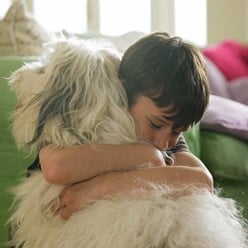
A kid giving his dog a hug
5. Hug your dog!
Our pups associate touch with feelings of happiness and belonging. When we give a hug our bodies (both human and canine) release oxytocin, a feel-good chemical, which has a significant positive impact on the body. Something as simple as a hug can strengthen the bond between man and man’s best friend. It has been proven that a dog who feels safe and secure not only physically but emotionally is much less likely to exhibit destructive behaviors within their environment ex. chewing on furniture or using the bathroom in the house. Give a hug and you will build their confidence, strengthen your bond, and live in harmony.
There you have it, 5 tips that will enhance you and your pup’s life far beyond what you can imagine. Everyone needs a few tricks for those challenging circumstances, to keep your pet operating smoothly and cultivate a loving bond. Now you can feel like an expert in your own home and share these amazing tips with all your pet parent pals. Do you have an amazing pet parenting tip that has worked for you? Tell us about it in the comments below!
Just Around the Corner offers daily Dog Walking , Dog Hiking, and Pet Sitting in Plymouth, MA. To learn more about how Just Around the Corner can help, check out our Services Page. You can also Contact Us for more information. Be sure to Like us on Facebook and Follow us on Instagram!
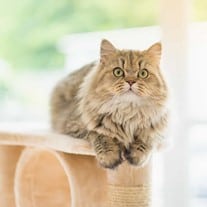
by Pam Ranheim | Jan 13, 2021 | cats, pet sitting, pets, Plymouth MA
The happiest homes are the ones that operate in harmony for both kitties and kitty owners. Are you dying to finally get your cat’s spraying under control? Or maybe you just want to own one piece of furniture that isn’t completely destroyed from Lily’s incessant scratching. Maybe you just wish Sebastian wasn’t so skittish. First and foremost, the idea that “cats can’t be trained” should be smashed as you move into the first steps of cat training. It is important to be of the mindset that our cat’s unwanted behaviors are natural but do not have to be permanent. Whether you have a new kitten who needs the foundation of house rules or you have an adult cat who could use some corrective instructions, these Five Training Tips will have your cat-occupied household living in harmony in no time.
1. Avoid Punishment
When training a cat or working to correct certain behaviors it is important to remember not to scold, swat, or make threatening sounds or movements. Punishing reactions will instill fear in your cat and create a hostile environment, leading to nervous “misbehaviors” causing more frustration for everyone involved. While it may be challenging not to burst out at your cat when they scratch your favorite armchair or urinate in the study rather than the litter box, yelling or hitting is a short-term solution to what can become a long-term problem. Above all, remember to pause a moment before reacting. Take a few deep breaths, and then proceed with a corrective behavior rather than a punishing one.
2. Deterrence and Corrective Behavior
As you take a moment to breathe, racking you brain for positive alternatives to unleashing your present frustration, consider having a sound that will signal “No” to your cat and one or two corrective steps to follow. For example: A clap or clicker will get the cat’s attention followed by you lovingly picking them up and removing them from the armchair they are scratching away on. Chances are they are scratching your special chair because it smells like you and they are just trying to mix their scent with yours. Isn’t that sweet! Try moving a scratch pole next to the area they love to go to town on as an acceptable alternative. Repeat this process and soon you will only need the whistle followed closely by your cat going straight for the scratch pole every time!
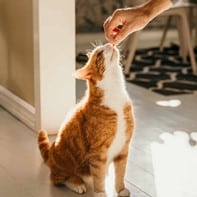
A photo of an indoor cat receiving positive reinforcement via a treat
3. Pawsitive Reinforcement
Now that you are seeing pawsitive results from deterring and correcting certain behaviors it’s time to show your kitty some appreciation! As your cat begins to adjust their misbehavior to preferred behavior, they are putting in hard work that you as their owner should be recognizing. When we break a bad habit we often look and hope for some type of reward at the end of the tunnel, right? Like us, our sweet kitties need positive reinforcement to rest assured they are doing it “correctly” (until they get used to it) and to promote listening/learning for the future. For example, my boy kitty, Blue, is a great cat in all ways but one – he never really learned to “squat” in the litter box, and when he pees his aim is always towards the wall. We tried several types of boxes, had the vet check for medical issues, and used other deterrents to fix his ‘direction’. What ended up working best is noticing when he squats and praising the heck out of him as he pees. He really soaks it up, and the wanted behavior becomes more frequent. Try one of the positive reinforcements below with your kitty.
- extra loving
- treats
- time playing with them
- cat nip
4. Nature vs Nurture
By nature, cats scratch, climb, and hunt so when we can provide activities and opportunities that allow for these behaviors in an acceptable manner it’s a big win for your kitty. In addition to easing their natural instincts we as cat owners should spend time actively playing and engaging with our cats part of every day. As we play with our kitties those natural instincts can kick in, and gentle play can turn intense quickly. To avoid playtime escalation, use many different toys to keep changing their focus and avoid letting them latch onto YOU. If your cat starts to play forcefully give them a toy and remove yourself from playtime. Not engaging in the aggressive behaviors will signal to your cat it is unacceptable. See the list below for a few ways to nurture their natural instincts in your home.
- Window watching perch
- Mouse or bird-like toys
- Climbing tower
- Fountain
5. Litter Box 101
Luckily there have been cat owners who have gone before us and discovered a few rules of thumb when it comes to litter box etiquette. If you are having trouble getting your cat to consistently use the litter box you provide it is possible that one of these faithful rules is being missed even if only by a hair, literally. Proper litter box etiquette is as follows.
- One box per cat plus one. Ex. 1 cat = 2 boxes; 2 cats = 3 boxes; 3 cats = 4 boxes
- Each box should be 1.5 times the length of your largest cat.
- Scoop 2x/day and change litter fully once a week; clean the box thoroughly before adding the new litter.
In addition, just like you might have a preference in toilet paper, your cat may prefer one litter over another. For example, one of my cats will ONLY use a Breeze System litter box; my other three cats are very happy with their regular litter box with The World’s Best Cat Litter. Just like with a pet’s food, you can’t change a cat’s litter abruptly. Introduce any new litter slowly, mixing it in with their regular litter and slowly changing the ratio until they are comfortable with the new smell and feel. There are always exceptions to the rules, but these three tips are an excellent starting point for any cat owner. Your kitty will thank you for the extra box, the spacious room, and clean litter.
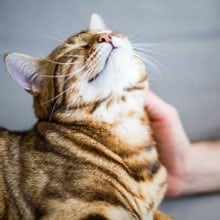
Cat receiving some love from their parent
No matter where you are in your cat parenting journey you can stary implementing these 5 steps today! Create a happier, more harmonious household for you and your kitties by using corrective behaviors, understanding their nature and where you can nurture that. Don’t forget to breathe before redirecting and always reward good behavior. Simple tweaks to their environment like using the appropriate number and size of litter boxes and providing useful alternatives for their natural habits will make all the difference in your feline occupied home. Have you tried other cat training techniques that work for you and your fur baby? Let us know in the comments below!
Just Around the Corner offers daily Dog Walking , Dog Hiking, and Pet Sitting in Plymouth, MA. To learn more about how Just Around the Corner can help, check out our Services Page. You can also Contact Us for more information. Be sure to Like us on Facebook and Follow us on Instagram!

by Pam Ranheim | Jan 6, 2021 | cats, dog walking, dogs, pet care, pet health, pets, Plymouth MA
Whether your pet loves or hates it, winter is an inevitable part of all our lives. Knowing what is best for your pet is the key to keeping them happy and healthy through the cold and usually dreary months. Fun fact, when our pets feel safe and healthy they will naturally enjoy whatever season they are experiencing. So, let’s dive right in to eight great ways to keep your pet happy and healthy this winter!
1. Know Your Pet
No one knows your pet like you do. Therein lies the joy and responsibility for using your best judgement when it comes to pet activities and outings during the winter months. Only you can discern if Lily the kitty can play out in the screened in porch a few minutes in the afternoons, or if Duke your Chihuahua should be indoors 100% of the time since he never stops shivering, or if Esmerelda the St. Bernard can spend hours enjoying the backyard and never get too cold. Trust the knowledge you have of your pet and keep a watchful eye on them so you can adjust as necessary.

A cat sitting on a windowsill inside to keep warm during winter
2. Paw Check!
Snow and ice and sand OH MY! After every outing be sure to wipe your pet’s paws thoroughly. Make sure you remove any snow/ice clumps and clear out grainy ice melt or sand as it can get embedded in their fur and paw pads making a simple task like walking extremely uncomfortable for them. Not getting anywhere with the typical towel cleaning? Try a Dexas Mudbuster to make life a little easier and ensure your pet’s paws are free of debris every time!
3. Shine Bright
Surprise! It gets dark around 4:00 PM during the winter, so chances are at least one walk a day is in the dark. Always wear reflective gear (both you and your dog) along with a light (preferably flashing) to ensure you are visible to other walkers and vehicles. Why you AND your dog? Heaven forbid your dog gets away from you! Being able to SEE them is of paramount importance to getting them home safe and sound. Shine brightly and stay safe this winter!
4. Leash up!
Did you know that pets have a greater chance of becoming lost during the cold season due to a lack of scents accessible to them? It is true! When heading out for a winter excursion or play date consider keeping your pet leashed up or making sure their play space is enclosed. In addition, always keep a collar with an up-to-date ID tag on them. Unsure about the terrain of a trail or what wildlife you may come across? Better to be safe than sorry, leash up and keep your loving companion safely by your side all winter long.
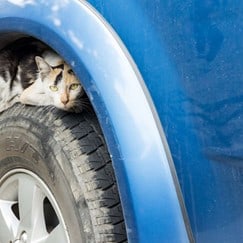
Cat hiding in car wheel to stay warm during the winter
5. Beware of hiding spots
Outdoor/stray cats and other small animals are always looking for places to stay warm during the winter. Before starting up your car or using a piece of machinery in your shed double check that somebody has not made themselves a cozy little home in there! Likewise, winter can be tough on nature. Pay close attention to where birds, squirrels, and other less “pet like” animals are nestling down on and around your property. Be mindful and do your best not to disrupt or destroy their winter homes.
6. Grooming
The winter is for letting ourselves go a bit, isn’t it? Well, our pets are right there with us for that one. Much like the cracking finger tips we experience from excessive hand washing our pet’s skin dries out much more quickly in the winter. While bathing is important unfortunately it washes away helpful oils that keep their skin moist, thus causing itching, irritability, and even painful cracking. In addition, when it comes time for a trip to the groomer be sure to ask that they leave a little more length than they do in warmer months. Our pet’s fur is a natural and necessary part of keeping them protected during the bitter winter months.
7. Antifreeze
Antifreeze is a deadly liquid that attracts pets due to its sweet taste. YIKES! Always clean up thoroughly after use and keep an eye out for any spills/leaking from your vehicle. Consider trying an alternative antifreeze that uses propylene glycol. Propylene glycol is less tasty, biodegradable, and does not cause kidney damage like ethylene glycol. No matter what product you use always keep out of reach of your pets to ensure their safety.

White dog with large stick enjoying winter snowfall
8. Winter Rule of thumb
Remember, if it’s too cold for you, chances are it is too cold for your pet. There are always exceptions to the rule but even if your dog is the “made for winter” type, such as a Husky or Newfoundland, they all have their cold weather limits. A great way to discern whether your winter loving pet will be safe and comfortable outside is to put on your winter coat and head outside yourself. However long you feel comfortable in the current elements is probably close to the same for your pup. Never assume your furry friend can handle the cold, snowy, or icy weather, test it out to keep them safe.
Winter is unavoidable here in New England so we might as well make the best of it! Understanding your pet and their needs will help you decide what actions to take when it comes to outdoor activities, proper grooming, and knowing their limits. Always cleanup toxic spills, remain visible when out at night, be mindful of the nature around you, and do what is best to always keep your pet safely in your care. These 8 simple tips will have your pet enjoying winter all season long.
Just Around the Corner offers daily Dog Walking , Dog Hiking, and Pet Sitting in Plymouth, MA. To learn more about how Just Around the Corner can help, check out our Services Page. You can also Contact Us for more information. Be sure to Like us on Facebook and Follow us on Instagram!



















Recent Comments